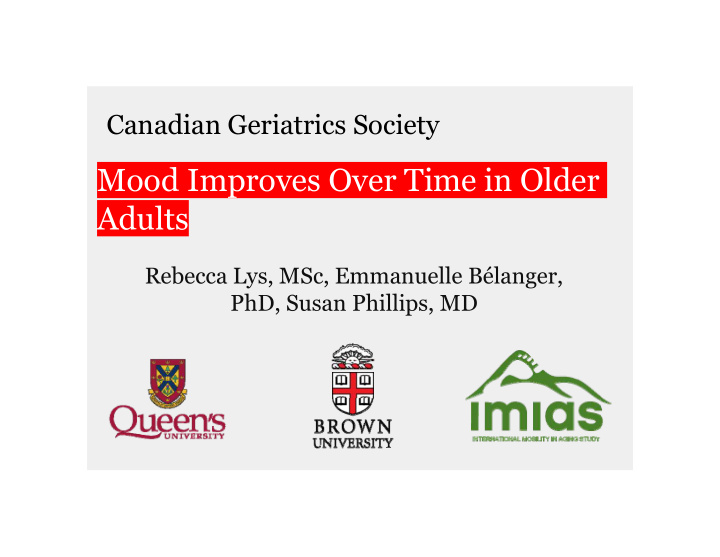



Canadian Geriatrics Society Mood Improves Over Time in Older Adults Rebecca Lys, MSc, Emmanuelle Bélanger, PhD, Susan Phillips, MD
Speaker Disclosure Presenter: Rebecca Lys Relationship with financial sponsors: None Financial Support: This program used data from the International Mobility in Aging Study, which received financial support from the Canadian Institutes of Health Research in the form of a 6- year team grant (2010-2016). (CIHR Grant AAM 108751) The authors have no conflicts of interest to declare. The authors have no potential bias to declare. 2
1. Introduction o Older adults are more likely to experience physical illnesses, which are risk factors for depression o Paradoxically, most research shows decreased prevalence of depression with age o Gender effects are unclear 3
The Role of Setting Country Rural living Evidence that prevalence Some studies show increased of depression decreases levels of depression in seniors with age in high-income living in rural settings countries vs middle- whereas others show no income countries difference. 4
Goal □ Understand the relationship between increased physical comorbidities and mood in older adults □ Compare changes in mood across gender and geographic setting 5
International Mobility in Aging Study (IMIAS) St. Hyacinthe, QC Kingston, ON Natal, Brazil Manizales, Colombia 6
Measure s Depression Grip Gender CES-D Grip strength Male vs Female 0 to 60 Measured in kg Controlling for depression 2012 Self-Rated Chronic Income Health Disease Sufficiency 1 (v. poor) to 5 (v. # of conditions 1 (insufficient) to 3 good) (v. sufficient) 0 - 8 7
Analyses – Depression over Time 12 Mean CESD (95% Confidence Interval) 10 8 6 4 2 0 2012 2014 2016 Kingston St. Hyacinthe Manizales Natal 8
Analyses – Men and Women Men and women experienced similar decreases in depression, but women had higher depression at any given time. Predictors of Improved Mood Men Women 1. High baseline depression 1. High baseline depression 2. Absence of chronic 2. Improved self-rated disease health Income sufficiency and grip strength were not significant predictors of improved mood. 9
Discussion Participants reported fewer depressive symptoms over time despite a decline in physical health. Depression scores were higher in women and middle-income sites compared to men and high-income sites at all times. Best predictor of improved mood: high initial depression score. Physical health declined, but self-rated health increased or remained stable. 10
“ Hum an happiness is a disposition of m ind and not a condition of circum stances.” - John Locke Older adults’ improved mood suggests an ability to separate physical illness from successful aging. Low mood in older adults should be considered a red flag, not an inevitable consequence. 11
Thank you! Any questions? You can find me at rlys@qmed.ca ? 12
Analyses – Survival Participants who were depressed in 2012 were more likely to be dead by 2016. � 2 = 23.477, p < 0.001 # of participants alive in 2016 1400 1271 1200 1000 800 600 400 248 200 53 31 0 Not depressed in 2012 Depressed in 2012 Alive in 2016 Died by 2016 13
Recommend
More recommend